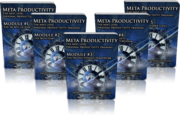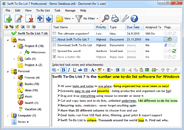GTD – you’ve seen it, heard about it and perhaps even meant to look into it, but never got the chance. So what is GTD, and what does it stand for? In the most basic terms, GTD stands for “Getting Things Done.” The term is borrowed from a book of the same name, subtitled “The Art of Stress-Free Productivity,” written by David Allen, a productivity consultant. However, since the original publication of the book in 2002, the concept of GTD has expanded far beyond the book, with Allen’s teachings inspiring a new generation of time management methods and efficiency-enhancing tools.
The explosion of mainstream technology, in the form of smart phones, net books and tablet computers, has served to provide ample opportunities for employing your own personal GTD methods, but it has also created an atmosphere ripe with distraction and potential for inefficiency. The key is creating a balance by – to borrow terms from Allen’s book – maintaining proper perspective and control of the tools of your trade.
While you may be tempted to cut corners as a means for GTD, that’s not what GTD is at all. Rather than forcing you to accept impaired productivity due to the inefficiencies of your resources and your efforts, GTD allows you to streamline the work process to get everything that you need accomplished finished and polished in the time you have. Instead of cutting corners, adopting GTD practices is a process of rounding off sharp edges so that your tasks fit into the time allotted and in a properly prioritized order. It all comes down to perspective and control.
GTD on a Digital Desktop
Although GTD should be easier in a digital age, it is often more difficult. From the minute you start up your computer, you’re under assault by information – warnings from your anti-virus software, pop-up ads from the internet and perhaps underneath it all, information you actually need. For this reason, it’s important to make your desktop work for you. The best way – in addition to removing unnecessary startup tasks from your computer’s settings – is to employ a desktop GTD client, such as Swift To-Do List 7. Having such a tool essentially gives you a desktop secretary, as this program in particular not only allows the creation of a to-do list, but also offers multiple settings for reminders, the attachment of files and notes to items on your list and the ability to time how long you’re spending on each task. Swift-To-Do List 7 cuts to the heart of GTD, as it puts you in control of your work and gives you a broad perspective on what needs doing, when it needs doing, and how it can be done.
GTD and YOU
The primary benefit of GTD is that it takes stress off of you so that you can focus all of your efforts on the task at hand, one-by-one, until everything is finished. A tenet of GTD is not relying on your memory to put things in proper order and remember when assignments are due. GTD preaches creating external reminders, which is exactly what Swift To-Do List 7 does. You can choose to get desktop and e-mail reminders, and upon each reminder – or any other time you review your tasks – you can also see your personal notes, attached files, images, links and other relevant information associated with the task. And instead of seeing just one task in isolation, you can see all of the items on your to-do list, which gives you ample perspective and opportunity to control your workflow. Swift To-Do List allows you to relieve your brain of its mental notes so that you’re less prone to distraction and a wandering mind.
Timing is Everything
A key component of control and perspective is being aware of timing. You should have a timeline of your tasks and know not just how long you are spending on your tasks, but how long you can afford to spend. Thankfully, Swift To-Do List 7 has a timer integrated with the program, so you can see where you’re putting your temporal resources. And take it from me – having a timer on your screen keeps you on task!
In essence, GTD is what you know you should be doing but just haven’t had time to implement yet. Luckily, as soon as you adopt GTD practices, you’ll enhance your perspective and control and have more time than ever to tackle your tasks.
This tutorial is written by Brian J. Willett.






[...] to adopt GTD practices. Taking simple steps within the large realm of GTD practices – such as changing your perspective and taking control — can put you on the path toward increased efficiency and improved work performance. So how [...]